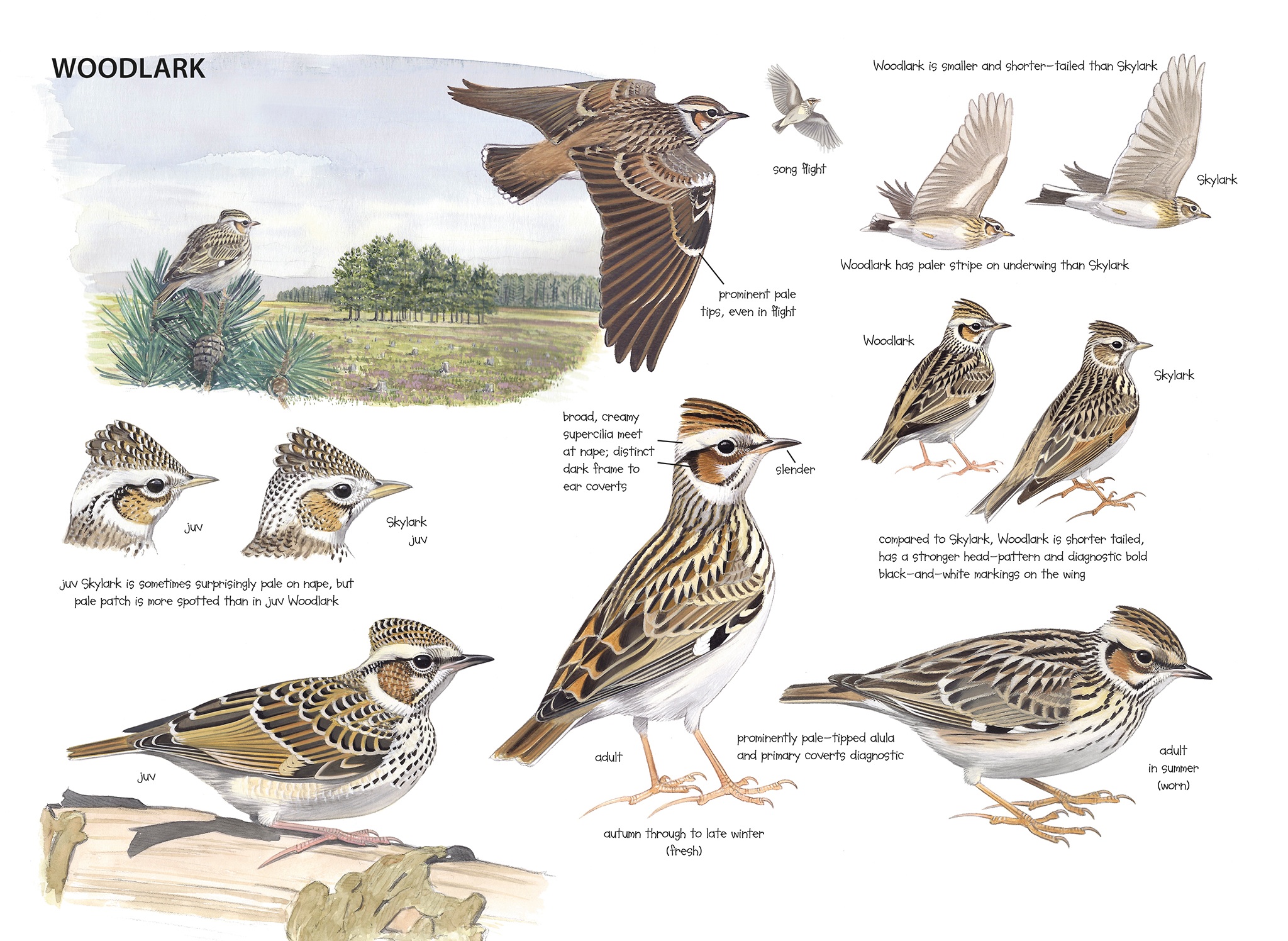
Killian Mullarney
When you are impatient for spring, and you think you have the flu but really it’s just winter reaching right to your soul, and you read of Woodlarks breeding from February and singing on moonlit nights, you want to experience it… badly.
There’s something about birds that sing at night, even as I write, I feel the itch to find one. The song is so beautiful, and it is often delivered in flight. In this example, it was recorded in the morning after rain using a parabola (CD2-69), but with luck you might hear the same sound floating around above your head in pitch darkness.
When they sing from perches or from the ground, male Woodlarks can sing much more simple songs, which are musical all the same (CD2-70). I have also read that female Woodlarks sing. Killian and I watched a pair feeding on the ground.
CD2-69: Woodlark Lullula arborea Kootwijk, Gelderland, Netherlands, 08:15, 3 May 2000. Song in flight. Background: Wandering Crossbill Loxia curvirostra type A. 00.005.AB.01034.02
CD2-70: Woodlark Lullula arborea Kootwijk, Gelderland, Netherlands, 11:05, 3 May 2000. Short songs of a male, with occasional calls of a female, both on the ground close to the nest. Background: Tree Pipit Anthus trivialis and Mistle Thrush Turdus viscivorus. 00.005.AB.04731.12
The male flew to its song perch and the female flew past us singing (CD2-71). In autumn and winter, it is sometimes possible to hear Woodlark subsong, which can give away the location of an otherwise unnoticed flock (CD2-72).
Woodlarks calls are often reminiscent of their songs, and can be highly variable. Listen to the calls given by this foraging flock in a brief recording of migrant Woodlarks in autumn (CD2-73). The harsh call at 0:06 is a threat call, which has a very similar harsh quality across a wide range of passerine species.
CD2-71: Woodlark Lullula arborea Morden bog, Dorset, England, 05:09, 16 June 2010. Song of a female in flight. Background: European Stonechat Saxicola rubicola, Common Chaffinch Fringilla coelebs and Yellowhammer Emberiza citrinella. 100616.MC.050900.04
CD2-72: Woodlark Lullula arborea IJmuiden, Noord-Holland, Netherlands, 29 September 2002. Subsong of an individual, foraging in a flock during autumn migration. Background: Dunnock Prunella modularis, European Robin Erithacus rubecula, Great Tit Parus major and Common Reed Bunting Emberiza schoeniclus. 02.042.MR.10519.12
CD2-73: Woodlark Lullula arborea IJmuiden, Noord-Holland, Netherlands, 28 September 2002. A variety of calls including harsh threats from one of two individuals squabbling. This was a foraging flock of about 12 migrants. Background: Meadow Pipit Anthus pratensis and Eurasian Magpie Pica pica. 02.041.MR.14805.12
One particular call, often used in alarm, is a bit monotonous (CD2-74). When flushed, Woodlarks often give a quiet, bubbling call before they launch into anything louder (CD2-75). Calls given while migrating are quite variable, but can always be recognised by their musical quality and, when present, by those quiet bubbling notes, interspersed between the louder more musical notes (CD2-76). There was also an example of two migrating Woodlarks under A flock of birds forever in flight (CD2-16).
CD2-74: Woodlark Lullula arborea Azrou, Middle Atlas, Morocco, 10:28, 26 March 2002. Calls of a pair, almost in alternation. The higher-pitched calls sometimes overlap with fragments of song from the other individual. So, presumably the lower-pitched whistles belong to the male and the higher-pitched calls to the female. 02.004.AB.03257.01
CD2-75: Woodlark Lullula arborea IJmuiden, Noord-Holland, Netherlands, 29 September 2002. Pu-pu-pu calls of a flock of eight autumn migrants when flushed. Background: Meadow Pipit Anthus pratensis and Dunnock Prunella modularis. 02.042.MR.10827.01
CD2-76: Woodlark Lullula arborea de Nolledijk, Zeeland, Netherlands, 11:03, 8 November 2005. Calls of a single individual while migrating, including quiet pu-pu-pu calls. Background: Common Chaffinch Fringilla coelebs. 05.030.MR.13314.22
Juvenile Woodlarks have tiny, high-pitched calls, which remind Killian and me of a Meadow Pipit (CD2-77). This bird was photographed by Nick and sound-recorded by Killian, and is celebrated again in Killian’s plate.
CD2-77: Woodlark Lullula arborea Morden bog, Dorset, England, 04:33, 17 June 2010. High-pitched, three-note calls of a juvenile and typical whistles of an adult. Background: Common Blackbird Turdus merula and European Robin Erithacus rubecula. 100617.KM.043300.02